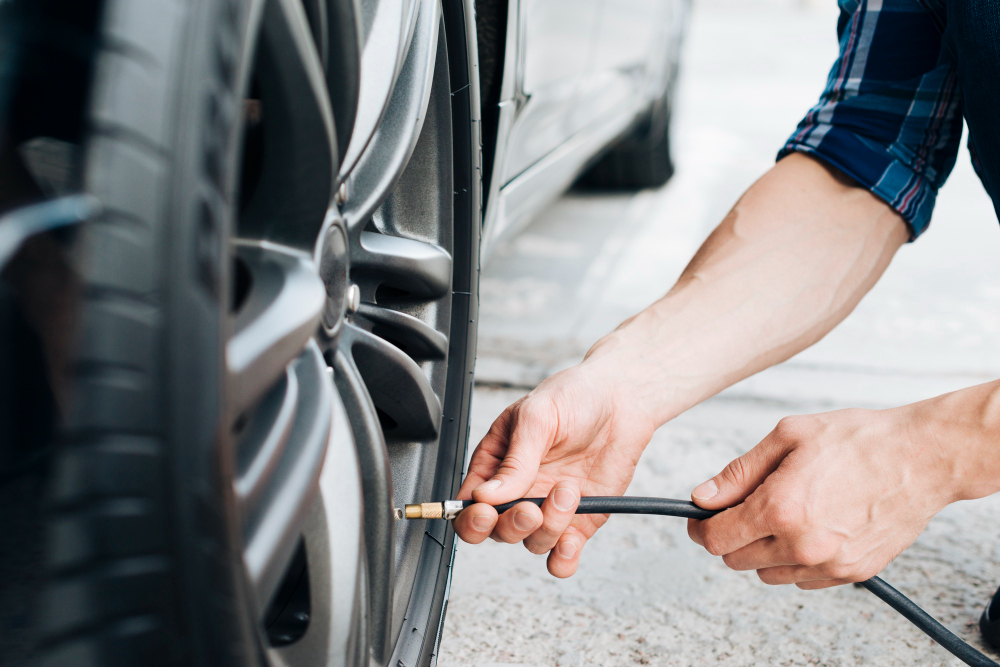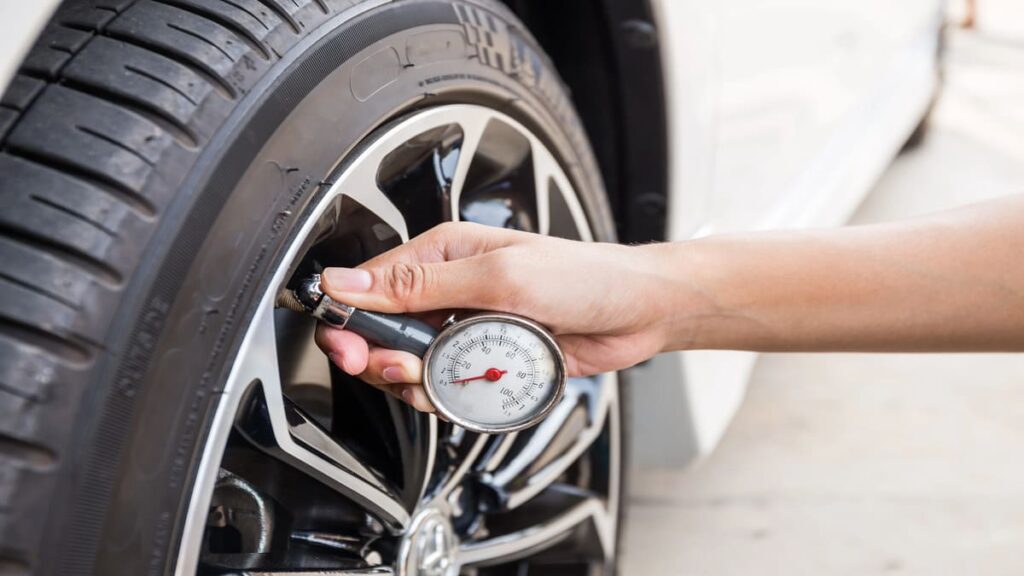A tire pressure gauge is a vital tool for checking a vehicle’s tire air pressure. Properly inflated tires are crucial for safety, fuel efficiency, and tire longevity. Using a tire pressure meter regularly ensures optimal tire performance and reduces the risk of tire-related accidents. A gauge for tires, such as a digital tire air pressure gauge, helps maintain the correct pressure, crucial for the overall health of your vehicle.
To explore more about tire pressure gauges, here’s a post to guide you. Let’s dive in.
How Does an Air Pressure Gauge for Tires Work?

An air pressure gauge measures the air pressure inside a vehicle’s tire. When attached to the tire’s valve stem, it reads the pressure, typically in pounds per square inch (PSI). This measurement helps determine if the tire needs inflation or deflation. The device, such as a tire pressure indicator, works by allowing air to press against a calibrated mechanism. It provides an accurate reading. Whether it’s a manual or a digital tire air pressure gauge, this tool is essential. It ensures your tires are at the ideal pressure for safe and efficient driving.
Is the Reading of All Types of Tire Pressure Gauges Accurate?

Tire pressure gauges vary in accuracy. Digital models generally offer more precise readings than analog ones. For everyday use, a standard tire pressure indicator is sufficient. However, for vehicles like performance cars, a more precise digital tire pressure indicator is recommended. Accuracy also depends on regular calibration. Choosing between different types, like a digital tire air pressure gauge or a traditional analog gauge, often comes down to personal preference and specific vehicle requirements. Choose a gauge that not only fits your needs but also provides reliable readings.
Is it Important to Check PSI Regularly?

Regularly checking your tire’s PSI is crucial. It ensures safety, maximizes tire lifespan, and improves fuel efficiency. Inconsistent tire pressure can lead to uneven tire wear, potential tire failure, and decreased vehicle performance. A portable air pressure gauge allows for easy and regular monitoring. Always try to keep your tires at the correct PSI, as recommended by the vehicle manufacturer. This way, you can significantly enhance your driving experience and reduce the risk of tire-related issues
Must Read: HOW OFTEN SHOULD YOU ROTATE YOUR TIRES? IS TIRE ROTATION REALLY NECESSARY?
How Much PSI Should Different Sizes of Vehicles Have?
The tire pressure varies depending on different sized tires and vehicle brands. Check out the guide below:
1. Passenger Cars:
Typically, passenger cars work best with a tire pressure of around 32-35 PSI. This range is ideal for balancing fuel efficiency, tire wear, and handling. Adhere to this pressure range as it affects the vehicle’s performance and safety. Using a tire pressure gauge regularly ensures that your passenger car maintains this optimal range.
2. SUVs and Light Trucks:
These vehicles are of large sizes. They have the capacity for heavier loads as well. Thus, they usually require a slightly higher tire pressure, around 35-40 PSI. This increased pressure helps accommodate the additional weight and provides better stability and tire longevity. Check the pressure with a reliable gauge for tires, especially before long trips or carrying heavy loads.
3. Trucks and Heavy Vehicles:
For these types of vehicles, the required tire pressure can be significantly higher, often exceeding 50 PSI, depending on the specific model and load they carry. The tire pressure impacts their performance and the safety of the heavy loads they transport. A precision tire gauge is often used to ensure accurate readings due to the higher pressures involved.
4. Performance or Sport Cars:
These cars generally need higher tire pressures, around 40-45 PSI, to enhance their handling and performance. The exact pressure can vary depending on the vehicle’s make and model, as well as the type of tires used. Performance cars benefit from a more precise tire pressure check, often using a digital tire air pressure gauge for accurate measurements.
Maintaining the correct PSI for your vehicle type is crucial. It affects everything from handling and fuel efficiency to tire life and safety. Regularly using a tire pressure tool or performing a tire PSI check is the best way to ensure your vehicle operates at its best. Whether it’s a simple daily commute or a high-performance drive, the right tire pressure makes a significant difference.
How Many Types of Tire Pressure Gauges Are There? And How to Read Them?
Tire pressure gauges come in various types. Each type has its own method of operation and level of accuracy. Understanding these types and how to read them is essential for proper tire maintenance.
1. Stick or Pencil Gauges:
These are the simplest and most economical gauges. They look similar to a pen. They have a slender body with a scale printed on them. When inserted into the tire valve, the air pressure pushes a calibrated rod out, displaying the pressure reading. They are easy to use and offer less precision than other types.
2. Dial or Analog Gauges:
These gauges feature a circular dial with a needle that points to the pressure reading on a numbered scale. They are typically more accurate than stick gauges. They can be easier to read. Many come with additional features like a bleeder valve for adjusting pressure.
3. Digital Gauges:
These provide the most accurate readings. They display the pressure on an electronic screen. Digital gauges are very user-friendly. They often feature backlit displays for easy reading in low light. They are preferred for their precision, especially in critical applications where exact tire pressure is crucial.
4. Tire Pressure Monitoring System (TPMS):
Integrated into some modern vehicles, TPMS continuously monitors tire pressure. It provides real-time updates and alerts if the pressure falls below or rises above the recommended level. Reading a TPMS involves checking the vehicle’s dashboard display, where the pressure is digitally shown.
Each gauge type has its strengths and suits different needs and preferences. Whether it’s for a regular check-up or precise monitoring, choosing the right type of tire pressure gauge is key to maintaining optimal tire performance and safety. Regular use of these tools helps ensure that tires are properly inflated, enhancing vehicle handling, prolonging tire life, and ensuring a safe driving experience.
In summary,
Choosing the right tire pressure gauge, whether it’s a simple manual gauge or an advanced TPMS tool, is essential for maintaining your vehicle’s tires. Regular use of a tire inflation gauge, adhering to the recommended PSI, and understanding the different types of gauges can greatly enhance your vehicle’s performance and safety. It’s a simple yet crucial aspect of vehicle maintenance that should not be overlooked.
FAQ’s about Tire Air Pressure:
Q. What is the correct air pressure for tires?
A. It depends on your car! Check the sticker on your driver’s door or consult the manual for the specific PSI recommended for your vehicle. Most car’s air pressure range between 30-35 PSI. Remember, check the pressure when the tires are cold!
Q. What happens if tire pressure is high?
A. High tire pressure can lead to reduced traction, uneven wear, and a harsher ride. It may compromise handling, increase the risk of a blowout, and negatively impact on fuel efficiency and braking performance.
Q. How do I read a tire pressure gauge?
A. To read a tire pressure gauge, unscrew the valve cap, press the gauge onto the valve stem, and read the pressure displayed on the gauge. Compare it to the recommended level for accuracy.
